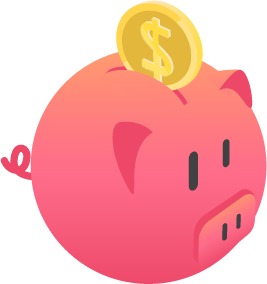Savings Goals
Net Worth
 Savings Goal Timeline Calculator
Savings Goal Timeline CalculatorThis calculator will figure how long it will take you to reach a desired savings goal based on your current savings, how frequently you contribute money, how much you contribute each time & the stated annual percentage rate (APR) on your savings account.
Guide published by Jose Abuyuan on September 30, 2020

Saving money is the cornerstone of long-term financial stability. By setting aside money today, you take on a path to a worry-free life. Your savings can cushion the blow of emergencies and other unexpected events. Saving money will also help you finance major life purchases such as buying a house and a car. It also allows you to buy cool stuff you’ve always wanted. Thus, building the life you want starts with saving.
But as with many things, the first step is the hardest. Most people find it difficult to set aside money. It’s even harder today to reach major savings milestones. Other people despair that they may never afford their own home or car. Fortunately, this needn’t be the case.
If you’re new to saving, you’re probably overwhelmed by your own expectations. True enough, everything from a comfy retirement to a six-month emergency fund is a tall order. And often, you might not even know how much money you can spare for savings. If you’re not careful, the daunting task of saving can kill your motivation.
This is why it’s important to manage your expectations. Be strategic when setting your goals; think long-term, but start small. You won’t be living large overnight. But you can save at least $500 in a reasonable length of time.
As with most goals, the best way to create a robust savings plan is by breaking it down into tiny, manageable pieces. The individual steps must be so small that they are impossible not to do. Save a little money today, then work your way up. The small steps approach is good for both attaining progress and building confidence. Simplicity is also an excellent motivator. This keeps you from procrastinating or giving up because it’s too easy not to do.
Once you start saving, begin by setting aside whatever extra cash you have. Take any leftover cash you can spare and put it away. Twenty dollars on your couch? Five dollars you found on the street? Be it spare change or windfall money, use it to your advantage. Every little bit counts.
At first, you can do it old school. Shove that money into a secure place, such as the traditional piggy bank. As soon as you’ve earned enough, you can put that money into a savings account. Once you’ve made a deposit, start the process all over again. You may continue doing this even after you’ve dedicated a real budget for savings.

Your first task is to set primary goals. What do you need to save for? Not everyone will have the same goals. If you’re single, your biggest goal might be to buy a car or start investing. If you’re engaged, you likely need to add your wedding expenses to that list. Once you have kids, you should consider college funds.
The next step is to quantify these goals. Since you’re dealing with money, aim for a specific dollar value to mark your milestones. This is a clear step toward reaching that goal. Once that’s done, arrange them according to priority. This will help you outline how you need to plan your budget.
For our example, we will assume you and your spouse are newlyweds who expect to have a baby soon. You both have a take-home pay of $62,400 each year, or $5,200 per month. This rounded figure is a little above the median U.S. household income in 2018. Throughout this article, we will assume that you save in increments of $200, $500, and $1,000.
Based on our example, here are some of the typical goals you must meet arranged according to priority. Figures marked with an asterisk are annual goals.
| Goal | Target Value |
|---|---|
| Starting Emergency Fund | $2,500.00 |
| Full Emergency Fund (6 months monthly income) | $31,200.00 |
| 401(k) Plan* | Maximum $19,500 |
| 529 College Education Plan* | Between $15,000 and $30,000 to avoid gift tax |
| Car Down Payment | 20% ($3,945.60) |
| House Down Payment | 20% ($62,640.00) |
The car down payment is based on the market price for a 2020 Toyota Corolla at $19,728. The house down payment assumes a price of $313,200, the median home price in the second quarter of 2020.
This technique can also be used to save up for the things you want to have. And on that list, you may add a dream vacation or a new home theater in your family room.

If money is tight, prioritize your own retirement before contributing to your child’s college education. By securing your future, you free your child from financial burdens as you age. That said, begin contributing as soon as you are able. The earlier you save, the more you can set aside college funds for your child.
Your first major financial goal should be an emergency fund. How much you’ll need to save for this will vary. Many financial experts agree that the more emergency money you have, the better. The standard amount is usually between three to six month’s worth of income, which is about the time it takes to look for a new job. A few professionals even suggest a full year’s salary.
This can be a challenge for most low-income earners, who may already have trouble saving. In 2019, economist Emily Gallagher and her colleagues bucked the trend by suggesting $2,467 to be enough. Although this is a good starting point, it is not enough in an economic crisis. Professor Gallagher herself added that her past advice cannot apply in crises such as the 2020 COVID-19 pandemic.
For our next example, we’ll assume that you opened a savings account with a 2 percent annual percentage rate (APR). Here’s how long it’ll take to earn a $2,500 basic emergency fund if you saved $200, $500, and $1,000 per month:
| Monthly Addition | $200 a Month | $500 a Month | $1,000 a Month |
|---|---|---|---|
| Number of Deposits | 13 | 5 | 3 |
| Term | 2.08 Years | 0.42 Years | 0.25 Years |
| Amount Deposited | $2,600.00 | $2,500.00 | $3,000.00 |
| Interest Earned | $30.54 | $12.53 | $10.01 |
| Final Savings | $2,630.54 | $2,512.53 | $3,010.01 |
By setting aside $500 per month, you’ll reach your emergency savings goal within the span of five months. You'll also receive an extra $12.53 for it. Based on this example, let’s see how long it’ll take you to earn a full emergency fund worth six months of income:
| Savings Details | Amount |
|---|---|
| Number of Deposits | 55 |
| Term | 4.58 years |
| Amount Deposited | $30,012.53 |
| Interest Earned | $1,563.69 |
| Final Savings | $31,576.22 |
The interest you earn from your savings will shorten the time it takes to meet your savings goal. In four years and seven months, you would’ve earned $31,576.22, $376.22 more than your original goal.

Replenish your emergency funds each time you use them. Make rebuilding these funds your top priority after recovering from an emergency.

At the core of every savings strategy is compound interest. This is what really makes your savings grow. In simple terms, compounding is interest you make on interest. Your bank adds the interest you’ve earned over an incremental period to your starting principal. With each compounding period, your interest earnings and principal grows. And if you make consistent deposits, your savings grows along with it.
A popular saying, attributed to Albert Einstein, claims that compounding is the eighth wonder of the world. Another genius of renown, Ben Franklin, described it best: “Money makes money. And the money that money makes, makes money.”
Let’s go back to our first example. Let’s say you ramp up your monthly savings to $1,000. Here’s how long it’ll take to earn the down payment for your house:
| Savings Details | Amount |
|---|---|
| Number of Deposits | 60 |
| Term | 5 Years |
| Amount Deposited | $60,000.00 |
| Interest Earned | $3,152.43 |
| Final Savings | $63,152.43 |

Keep in mind homes may appreciate while you are saving up for your down payment, so a down payment savings goal can be a moving target. A 20 percent down payment on a $250,000 home would run $50,000. If saving that much took you a half-decade you may need more than $50,000 if real estate appreciates.
If you believe real estate is likely to appreciate at 3% a year and your initial goal was a half-decade away you may need to save an extra 16% to reach your down payment savings goal.
Compounding can shorten the time it takes for you to meet your financial objectives. It’ll take you exactly five years to surpass your savings goal. Through compound interest, you shaved off three months off what you need to earn for a down payment. If you saved up a bit more after that anyway, you’ll even have a little more to spare for your closing costs.
Compound interest became the subject of the comedy series Futurama. Stuck in 3000, protagonist Philip J. Fry visited his bank to check on the paltry 93 cents he deposited in 1999. The teller calmly tells him that, based on an APR of 2.25 percent, his current balance amounts to $4.3 billion. Unrealistic premise aside (what about taxes and inflation?), that scene was based on actual math:
| Savings Details | Amount |
|---|---|
| Number of Deposit Periods | 11,881 |
| Term | 990.08 Years |
| Amount Deposited | $0.93 |
| Interest Earned | $4,306,734,536.22 |
| Final Savings | $4,306,734,537.15 |
Compounding every month, Fry’s account would’ve reached $4.3 billion by 3990! Of course, reality is a lot less straightforward than that. You can’t just leave your money in a savings account and hope to rake in the big bucks. You’ll need to put your money in other asset classes to increase your yield in the long term.
This gag does impart the lesson that time is your greatest ally. The longer your savings and investments are left to compound, the more money you’ll earn. You can, over several years, build up a modest fortune simply by putting your money away.

To make the most money, follow this simple, time-tested rule: don’t touch the capital. Money grows when it’s left alone. In addition, tax-deferred assets like IRAs and 401(k)s have tax penalties for premature withdrawals. Always add to your savings and investments, but avoid withdrawing from them unless you absolutely need to.

Before you begin, look into your finances and examine where your money goes. Do you have high living expenses? Are you in deep debt? These are important considerations when drafting a budget. Some of your long-term savings goals will only be possible when you increase your cash flow. This may require a lot of cost-cutting to achieve.
But how much do you need to save? The traditional amount allotted for savings was 10 percent. This is an easy enough number to reach, even for people with low incomes. But is this enough to earn for retirement? It depends when you start. As a young person, you have a wider time horizon on your side. However, you might not have a clear idea of how much retirement will cost. It also assumes that you’d want to delay retirement until the very end.
Most financial professionals and public officials, meanwhile, endorse the 20 percent rule. The larger savings amount lets you accumulate wealth faster over time, thanks to the larger principal you deposit. It is, however, a tall order. This is not an easy amount to achieve if you are just starting out. Neither is it practical if you’re contending with a high cost of living.
Moreover, remember that these rules are meant as guidelines. Don’t be afraid to bend or modify them as your situation demands. If you can’t commit 20 percent, for example, you can pick a much more reasonable savings goal. Tailor your savings strategy to suit your needs and goals.
One variation of the 20 percent savings rule is the 50-30-20 rule. This general budget plan divides your after-tax pay into three uneven parts. The largest of these, at 50 percent of your income, goes to your important needs. Here goes your basic expenses like food and utilities bills, rent, mortgage and minimum debt payments. 30 percent goes to discretionary expenses or wants. The 20 percent for savings can be divided into actual savings and extra debt payments.
This budget plan motivates you to examine each of your expenses up close. To succeed, you must ask yourself the hard questions. Are all your expenses under “needs” actual necessities? Can you do without some of them? To improve your cash flow, you often need to re-prioritize your expenses.
To build wealth, you must be prepared to take on risks. At the same time, you must also recognize that there’s an upper limit to the risks you can take. Thus, wealth-building through investing is a balancing act. Only expose your savings to risks you can afford to take.
The following chart analyzes the real rate of return of four different types of investment assets from 1950 to 2015. These figures are based on a comprehensive Harvard study tracking the real rates of return since 1875.
| Asset Class | Nominal Rate of Return | Real Rate of Return |
|---|---|---|
| Treasury Bills | 5.39% | 0.88% |
| Bonds | 7.30% | 2.79% |
| Equity (Stocks) | 12.97% | 8.30% |
| Housing (Real Estate) | 12.27% | 7.42% |
Treasury bills and bonds are cash investments, whereas equity and real estate are based on non-cash assets. Of these, stocks perform the best in the long-term. Their value is tied to the ability of a business to make money.
All investments come with risk, which is the likelihood of losing money. Risk carries the connotations of high stakes. Businesses may fail and lose money. Corporations lose and gain value capriciously over the short term. The biggest business risks are often described as gambles, and with good reason.
Even the safest investments are still called “low risk,” and their trade-off is their low returns. Compared to stocks, savings accounts are stable, since they’re only in jeopardy if the bank that backs them goes under. But their returns are miniscule, rarely going above 2 percent in ideal scenarios. Even putting your money in a jar comes with the risk of losing value to inflation.

Know your risk tolerance to see when to ramp up your savings and invest. Everyone’s risk tolerance is different; it’s not something you can quantify on a chart. However, risk tolerance is heavily associated with these three factors:
Age translates to time horizons. The younger you start saving and investing, the more risks you can take. Stocks, which are incredibly risky in the short term, grow phenomenally over time. A younger person has more time to weather through the short term risks than an older person. With retirement over the horizon, older adults can’t risk their hard-earned savings over the short-term.
But young people have smaller incomes and more debt. They’ll need that money to cover for emergencies, pay off debts, and build their lives. Thus, their ability to choose aggressive investments is also limited. If you’ve yet to build savings, focus on saving instead of investing aggressively. As your financial situation improves, so would your risk tolerance.
Besides time, knowledge is your biggest ally in investing. Don’t just fly blind. Learn all you can about each investment asset before investing money. You don’t want to be left holding the bag if things don’t go as planned.
The collection of investments you’ve made is known as a portfolio. In the past, this took on a literal collection of documents. But today, it’s mostly electronic. To build wealth in the long-run, you must create a portfolio that holds different kinds of assets. A diversified portfolio guarantees that you make money even if one asset under-performs.
Your asset allocation is the amount of money you invest on a specific asset. How you divide your investments will depend on your risk tolerance. If you can take on a lot of risk, your portfolio might be composed mainly of stocks. If you’re risk averse, bonds and treasury bills may instead comprise the majority of your assets.
Don’t expect your risk tolerance to stay the same over your lifetime. Make adjustments to your portfolio as your finances allow. You might be more risk-tolerant today than you were yesterday, and your finances should reflect that. Sometimes, you might need to rebalance your portfolio. This involves buying or selling assets to maintain your ideal asset allocation. If stocks go up in value, for instance, sell some of them or buy other assets.

A good, low-risk place to invest your extra money is in debt. Pay extra toward your consumer debts to clear them off faster. You could save thousands of dollars on interest payments, which is more than what you can get from investments in the short term.
A good savings plan combines clear goals, realistic expectations, and consistency. To succeed, you’ll need to create a workable plan that you can stick to for the long haul. Analyze your financial situation before committing to a savings budget. Compare that amount to how much you’ll need to meet your objectives and plan accordingly.
Don’t be afraid to start small. Over time, small steps can help you achieve your financial goals. In the meantime, use this opportunity to improve your cash flow. Besides making budget cuts, consider being aggressive with your debt payments. Each debt cleared saves you money and improves your cash flow. By having more money coming in, you increase the amount you can dedicate to your savings.
Want to know which expenses to cut back on? Read our guides on our generic products and smoking cessation calculators.
Jose Abuyuan is a web content writer, fictionist, and digital artist hailing from Las Piñas City. He is a graduate of Communication and Media Studies at San Beda College Alabang, who took his internship in the weekly news magazine the Philippines Graphic. He has authored works professionally for over a decade.